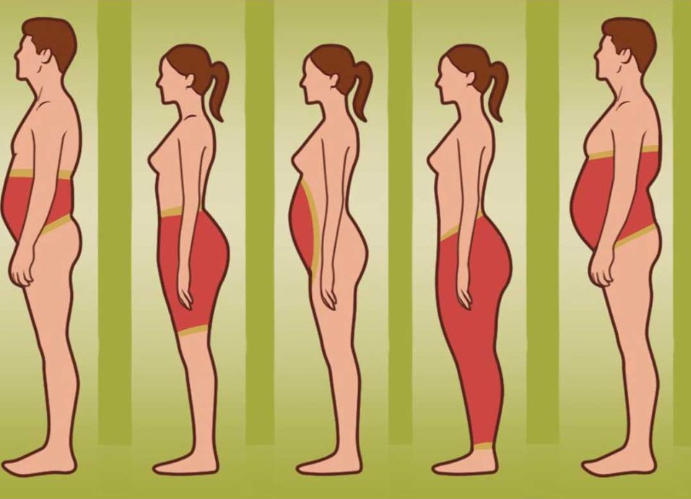Understanding how your body stores fat isn’t just about looks; it plays a significant role in your overall health. Your fat distribution can indicate potential health risks and help guide your lifestyle choices to improve well-being. Factors such as genetics, hormones, diet, and lifestyle greatly influence fat distribution. Knowing where and how your body stores fat can provide crucial insights for making informed health decisions.

1. Upper Body Fat (Apple Shape)
People with an “apple shape” tend to store most of their fat in the upper body, particularly around the abdomen, chest, and back. This type of fat is often visceral, situated deep within the abdominal cavity among vital organs.
What It Reveals About Your Health
Upper body fat, especially visceral fat, is strongly linked to insulin resistance, type 2 diabetes, and heart disease. It can elevate inflammation levels, contributing to a higher risk of metabolic syndrome. This form of fat distribution is hazardous due to its proximity to essential organs.
What You Can Do About It
To combat upper body fat, focus on:
- Cardiovascular exercises: Engage in activities like walking, running, or swimming to burn calories and reduce visceral fat.
- Strength training: Incorporate weightlifting or resistance exercises to build muscle and enhance fat metabolism.
- Healthy diet: Eat a diet rich in whole foods, lean proteins, healthy fats (like avocados and nuts), and plenty of vegetables to reduce inflammation and abdominal fat.
2. Lower Body Fat (Pear Shape)
Those with a “pear shape” carry more fat around the hips, thighs, and buttocks. This distribution is more common in women and, while less harmful than upper body fat, still has health implications.

What It Reveals About Your Health
Lower body fat is predominantly subcutaneous, lying just beneath the skin and poses less risk than visceral fat. However, it can lead to joint pain, varicose veins, and cellulite. While not as tightly linked to chronic diseases like heart disease, it can still cause discomfort and mobility issues.
What You Can Do About It
To reduce lower body fat:
- Aerobic exercises: Opt for cycling, running, or brisk walking to target fat reduction.
- Leg-focused strength training: Perform exercises like squats, lunges, and leg presses to tone your lower body.
- Balanced diet: Consume lean proteins, healthy fats, and low glycemic index carbs to maintain muscle mass and lose fat around the thighs and hips.
3. Total Body Fat (Overweight or Obese)
Evenly distributed fat across the body often indicates overweight or obesity, stemming from an energy imbalance—more calories consumed than burned.
What It Reveals About Your Health
Excess weight elevates the risk for numerous conditions, including cardiovascular disease, diabetes, joint issues, and certain cancers. Being overweight can affect almost every organ system, making it vital to address for optimal health.
What You Can Do About It
Managing total body fat requires a comprehensive approach:
- Calorie deficit: Monitor your calorie intake and aim to burn more calories than you consume through exercise and daily activity.
- Physical activity: Merge cardio and strength training for a balanced workout that targets fat loss and muscle growth.
- Behavioral changes: Address emotional or stress-related eating habits. Professional support from a dietitian or therapist may be beneficial.
4. Visceral Fat
Visceral fat is stored deep within the abdomen around internal organs, making it particularly dangerous as it often goes unnoticed until severe health issues arise.
What It Reveals About Your Health
High visceral fat levels significantly increase health risks, including inflammation, insulin resistance, and chronic diseases like cardiovascular disease and type 2 diabetes. This type of fat heightens the production of inflammatory markers, accelerating metabolic disorders.
What You Can Do About It
To combat visceral fat:
- High-intensity interval training (HIIT): Alternating between intense activity and recovery periods is highly effective at burning visceral fat.
- Low-carb diet: Limiting sugar and refined carbs helps minimize insulin spikes, contributing to visceral fat reduction.
- Stress management: Lowering cortisol levels through mindfulness, meditation, or yoga can reduce visceral fat storage.

5. Subcutaneous Fat
Subcutaneous fat is the kind just beneath the skin, accumulative in areas like the thighs, hips, and arms. It’s less harmful but can still pose health risks if it leads to obesity.
What It Reveals About Your Health
While not as immediately dangerous as visceral fat, excess subcutaneous fat can result in obesity, posing health risks. It can also be a cosmetic concern, leading to cellulite and sagging skin. Managing this fat type improves overall wellness and self-esteem.
What You Can Do About It
Reducing subcutaneous fat requires:
- Consistent exercise: Combining cardio and strength training is effective.
- Healthy eating: Focus on whole foods, lean proteins, and a balanced intake of healthy fats and complex carbohydrates.
- Hydration and sleep: Staying hydrated and getting enough sleep are crucial.
Conclusion: What Your Body Fat Says About You
Your body fat distribution offers valuable insights into your health risks and the steps to improve your well-being. Knowing where you tend to store fat is essential for addressing potential health issues.
By combining personalized exercises, a balanced diet, and stress management techniques, you can effectively mitigate the risks of unhealthy fat distribution. Focus on long-term lifestyle changes tailored to your specific distribution patterns and health goals.